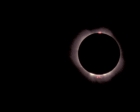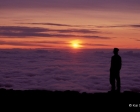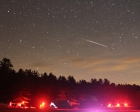Why go to Mars?
Stefan Meuleman and Alina Marktanner of the graduate program “Cultures of Arts, Science and Technology” (CAST) at Maastricht University, Netherlands are intrigued to learn about Mars One and its mission to place humans on Mars in 2023. They are investigating the endeavor from a socio-ethical perspective and requested an interview with me, as the Director of Business Development for Mars One.
-
Why go to Mars?
Humans have since prehistory been a species of migration and exploration. We are at our very core wanting to know the limit of the space around us and that which we are able to accomplish. While there are those who say to commit time, money, and resources on space exploration is to fail to first address problems here on Earth, I say we have always and will always have problems as that too is innate in our DNA.
But when humans walk on another planet, as they did on the Moon more than forty years ago, we will again have inspired the imagination and hopes of hundred of millions, perhaps billions of humans. Mars offers an opportunity to again see the potential good we can collectively do and at the same time, offer motivation to rise above the challenges which otherwise burden us here on our home planet.
What’s more, all endeavors in science, whether on the land, in the sea, on another planet offer valuable knowledge and the foundation for advancements which come back to promote and improve education.
-
How did you get involved in Mars One?
I contacted the Mars One team early in the summer of 2012, just one or two months after they launched their website. I asked if I could assist with business development, professional writing, and the like, and was immediately warmed by a return email. A few weeks later, we had come to an agreement and I came on-board.
-
What makes you support this project (rather than others)?
I am not so much made to support Mars One as I am compelled to play a part in what may be the greatest adventure any humans have ever undertaken.
-
Are you involved in any other societies and advocacy groups concerned with Mars missions (e.g. Mars Society, NASA)?
I am again a proud member of the Planetary Society as when I was a teenager. While NASA is not a society nor advocacy group, when I was CEO of Terra Soft Solutions (developer of Yellow Dog Linux), we provided supercomputers for NASA and several universities. I maintain contact with several former customers at NASA, especially now as my work with Mars One brings me back into their realm.
-
To what extent is Mars One continuous with recent developments in space travel? To what extent is it a novelty? We are speaking here about the growing commercialization of space exploration, the growing internationalization of space missions as well as the popularization of scientific findings in public media.
All the technology needed to take humans to Mars exists today. No major inventions are needed, rather, only modifications to existing systems and subsequent integration of components from various suppliers. As such, Mars One is “continuous” (in your words) with recent developments and helping to advance the human efforts to explore space beyond the planet Earth.
-
What is your standpoint on the dissemination of scientific facts through public platforms like forums and possibly real life TV shows? We would like to know, for instance, to what extent this form of distribution has a purpose in itself (e.g. informing the public) and to what extent it has instrumental functions (e.g. to get sponsors to finance the missions).
(a little confused by the question, but will do my best)
Science education is, in the U.S., on a downhill trend. Students are graduating from both high school and college with less of an overall understanding of the applied sciences than in generations past. Science is central to the understanding of how the universe works, from subatomic particles to bacteria, from patterns in economics and the weather to the formation of stars and galaxies.
Anything we can do, in any form, to help make science education exciting, and more important, within reach of all who express interest, is an objective worth working toward.
As for sponsors, they are what makes this mission possible. If we both educate and entertain in order to take humanity to Mars, that is not such a bad combination.
-
Besides being an entrepreneur and business developer, you are also a Science Fiction author and film maker. To what extent do you think Science Fiction can help to anticipate possible scientific endeavors like Mars One, and help in shaping mission plans?
Science Fiction has for nearly one hundred years played an important role in generating interest in science fact. You need only search Google or “science fiction as inspiration for science fact” to find such displays of this very reality:
- 10 current technologies directly inspired by science fiction
- 4 Star Trek technologies that are almost here …
Star Wars has inspired robot designers for two generations, and most recently Dean Kamen’s the “Luke arm” (after Luke Skywalker) both in form and function.I grew up with Star Wars and Star Trek both. They inspired me in different ways. I do not believe science fiction “anticipates,” rather, it inspires and encourages people to push the limits of what we can do. I remember when the Star Trek “Next Generation” TV series was produced, many of the gadgets and inventions or medical technologies used were discussed just six months prior in “Science Weekly” magazine. I later learned the staff of the Star Trek programs did in fact read current trends in real science and then incorporate them into their writing for the next show.
Did you know that scientists have developed the first steps toward a real Star Trek transporter? Would they have even attempted such a thing if it were not for the TV show?
- To what extent can Science Fiction harm those very things?
I grew up embracing the Star Trek utopian Starship Enterprise where people of all faiths, ethnicities, and backgrounds could work, play, and live together, united by a greater, common goal.
Yet this century has, more than any in human history, seen more conflict and war. In this way, science fiction and science fact have let all of us down. Wasn’t science suppose to cure all disease, rid the planet of famine, and end all wars?
Through my own continued science education and volunteer work around the world, I have come to learn that the same DNA which drives us to migrate and explore and always push for more also grants us the propensity to protect that which we claim to be our own at the cost of safety and justice for others. The Power of Word Association and The Red and the Blue discusses this human tendency to some degree.
As it is the goal of Mars One to select a diverse team for each mission every two years, Mars will be populated not by one ethnicity nor people of one religion, rather, by representation of all of humanity, slowly, over time. If we are successful in this endeavor, perhaps we will be one step closer to making real Gene Roddenberry’s dream.
* * *
Thank you for this opportunity.
Sincerely,
kai

















![[unknown] & scope, 2012, Mauna Kea, Big Island, Hawaii by Kai Staats [fusion_builder_container hundred_percent=](http://www.kaistaats.com/wp-content/uploads/2012/06/setup-85x128.jpg)



